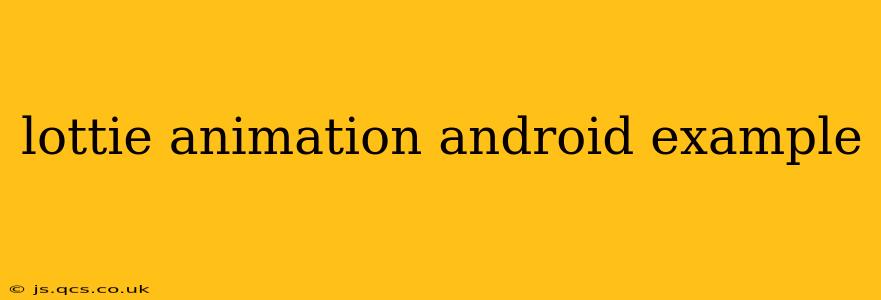Lottie animations offer a fantastic way to add engaging, high-quality visuals to your Android apps without sacrificing performance. This guide provides a comprehensive look at integrating Lottie into your Android projects, covering everything from setup to advanced techniques, answering common questions along the way.
What is Lottie Animation?
Lottie is a mobile library for Android and iOS that renders After Effects animations in real time, providing a lightweight and efficient solution for displaying complex animations. It supports a wide range of animation features, including vector graphics, text animations, and shape transformations. This allows designers to create stunning animations in After Effects and developers to easily integrate them into their apps.
Setting up Lottie in your Android Project
Integrating Lottie into your Android project is straightforward. You'll typically use the lottie-android library, available via Gradle.
1. Add the dependency to your build.gradle file:
dependencies {
implementation 'com.airbnb.android:lottie:5.2.0' // Check for the latest version
}
2. Sync your project.
3. Add the Lottie animation JSON file to your res/raw folder. You can export animations from After Effects as JSON files using the Bodymovin plugin.
How to Use Lottie Animations in your Android Layout
Once the library and animation file are in place, you can add the Lottie animation to your layout using the LottieAnimationView.
Example in XML:
<com.airbnb.lottie.LottieAnimationView
android:id="@+id/animation_view"
android:layout_width="wrap_content"
android:layout_height="wrap_content"
app:lottie_rawRes="@raw/your_animation"
app:lottie_autoPlay="true"
app:lottie_loop="true" />
Replace @raw/your_animation with the name of your JSON animation file. lottie_autoPlay and lottie_loop control automatic playback and looping respectively. You can adjust these attributes as needed.
Example in Kotlin:
val animationView = findViewById<LottieAnimationView>(R.id.animation_view)
animationView.setAnimation("your_animation.json") //If your animation is not in `raw` resources.
animationView.playAnimation()
animationView.loop(true)
Remember to replace "your_animation.json" with the correct path to your JSON file. This approach offers more dynamic control, allowing you to load animations programmatically and manage their playback.
How to Control Lottie Animations Programmatically
Lottie provides extensive control over animations via its API. You can control things like:
- Playing and pausing:
animationView.playAnimation(),animationView.pauseAnimation(),animationView.cancelAnimation() - Looping:
animationView.loop(true/false) - Progress:
animationView.progress = 0.5f(sets the animation to 50% progress) - Speed:
animationView.speed = 2f(doubles the animation speed) - Adding listeners: To respond to animation events, use the
LottieListenerinterface. For example, you could trigger an action when the animation completes.
How to Optimize Lottie Animations for Performance
Lottie is already very efficient, but you can further optimize performance:
- Reduce animation complexity: Simpler animations will render faster.
- Use vector graphics: Vector graphics scale without loss of quality, resulting in better performance across different screen densities.
- Cache animations: For frequently used animations, caching can improve performance. The library often handles this automatically, but consider manual caching for extreme cases.
What are the benefits of using Lottie animations?
Lottie offers several advantages:
- Lightweight: Smaller file sizes compared to traditional video animations.
- High-quality: Crisp and smooth animations thanks to vector graphics support.
- Highly customizable: Controllable via code, allowing for dynamic interactions.
- Efficient: Low impact on app performance.
- Easy Integration: Simple setup and integration with Android Studio.
What are the common issues when using Lottie Animation?
Common issues can include incorrect file paths, missing dependencies, or problems with animation rendering. Always check your JSON file path and ensure all dependencies are correctly included. Thorough testing and careful attention to detail during development will minimize issues.
How can I create Lottie animations?
Lottie animations are usually created using Adobe After Effects with the Bodymovin plugin. This plugin exports the animations as JSON files, ready for integration into your app.
This comprehensive guide should equip you to seamlessly integrate and manage Lottie animations within your Android applications. Remember to consult the official Lottie documentation for the most up-to-date information and advanced features.
